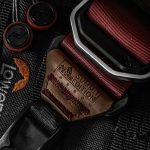You wear carbon Kevlar hybrid fabric because you want armor that’s both incredibly strong and light. It combines Kevlar’s flexibility and impact absorption with carbon fiber’s stiffness and tensile strength, giving you superior protection without sacrificing mobility. This fabric disperses energy efficiently, handles blunt and sharp impacts, and stays durable in tough conditions. It’s lighter and more flexible than traditional armor, reducing fatigue on long missions. Keep exploring to see how this tech is reshaping protective gear.
Table of Contents
Key Takeaways
- Carbon Kevlar hybrid fabric combines carbon fiber’s strength with Kevlar’s flexibility for superior lightweight armor performance.
- The hybrid fabric efficiently disperses impact energy, enhancing protection against bullets, blunt force, and sharp objects.
- Lightweight and flexible, it improves mobility and reduces fatigue compared to traditional heavy armor materials.
- Its durability and resistance to harsh conditions ensure long-lasting protective gear for military and law enforcement use.
- Manufacturing challenges include high costs and sensitivity to environmental factors, but advanced weaving optimizes strength and durability.
Understanding the Properties of Kevlar and Carbon Fiber
Although both Kevlar and carbon fiber are renowned for their strength, they offer different advantages that make each unique.
When you handle Kevlar, you’ll notice its exceptional toughness and ability to absorb energy, making it ideal for impact resistance. It’s lightweight yet flexible, so it conforms well to various shapes without compromising durability.
On the other hand, carbon fiber boasts incredible stiffness and tensile strength, giving you superior structural support and rigidity. It’s also lightweight but less flexible than Kevlar, which means it excels in applications where maintaining shape under stress is essential.
Understanding these properties helps you appreciate why combining these materials can create fabrics that balance durability, flexibility, and strength for advanced protective gear.
How Carbon Kevlar Hybrid Fabric Enhances Protection
When you combine carbon fiber with Kevlar, you get a hybrid fabric that enhances protection by leveraging the best qualities of both materials.
You benefit from carbon fiber’s incredible stiffness and strength, which disperses impact energy efficiently, reducing damage. At the same time, Kevlar adds exceptional flexibility and tensile strength, helping the fabric absorb and resist blunt force trauma or sharp objects.
This synergy means the hybrid fabric not only stops bullets but also manages energy distribution better than either material alone. You’ll notice it’s lighter, too, so you can move freely without sacrificing safety.
Applications of Carbon Kevlar in Military and Law Enforcement
The unique combination of carbon fiber and Kevlar creates a fabric that’s perfectly suited for military and law enforcement gear.
Carbon fiber and Kevlar blend to form gear that’s tough, lightweight, and ideal for military and law enforcement.
When you wear this hybrid fabric, you get unmatched protection without sacrificing mobility. Imagine facing dangerous situations with confidence because your armor is lighter and stronger.
Here’s how carbon Kevlar benefits you:
- Enhanced bullet resistance keeps you safer during critical moments.
- Reduced weight means less fatigue on long missions.
- Improved flexibility allows quick, unrestricted movements.
- Durability against harsh conditions guarantees your gear lasts longer.
Comparing Carbon Kevlar Hybrid Fabric to Traditional Armor Materials
Since you rely on armor to protect you in critical situations, choosing the right material can make all the difference. Carbon Kevlar hybrid fabric blends the strength of carbon fiber with the flexibility of Kevlar, offering superior performance compared to traditional armor materials like steel or pure Kevlar.
| Property | Carbon Kevlar Hybrid Fabric |
|---|---|
| Weight | Lightweight |
| Flexibility | High |
| Impact Resistance | Superior |
| Durability | Excellent |
| Cost | Moderate |
Unlike heavy steel armor, this hybrid gives you mobility without compromising protection. Its enhanced impact resistance surpasses pure Kevlar, while maintaining durability under harsh conditions. Although it’s slightly more costly than traditional options, the benefits in comfort and safety make it a smart choice for modern armor needs.
Manufacturing Techniques for Carbon Kevlar Hybrid Fabrics
You’ll find that weaving methods play an essential role in shaping carbon Kevlar hybrid fabrics.
By carefully integrating composite layers, manufacturers enhance strength and flexibility.
Let’s explore how these techniques come together to create high-performance materials.
Weaving Methods Overview
Although weaving Carbon Kevlar hybrid fabric involves complex processes, understanding the main techniques helps you appreciate how these materials achieve their unique strength and flexibility.
You’ll see that the weaving method directly impacts durability and performance.
Here are the key weaving methods:
- Plain Weave: Simple and strong, offering balanced strength and flexibility.
- Twill Weave: Diagonal patterns give enhanced drape and impact resistance.
- Satin Weave: Smooth surface with high tensile strength, ideal for sleek armor.
- Basket Weave: Interlaced fibers provide excellent shock absorption.
Composite Layer Integration
When you integrate carbon and Kevlar layers in hybrid fabrics, precise manufacturing techniques verify the materials bond effectively without compromising their individual strengths.
You start by aligning the layers to optimize load distribution, then use controlled heat and pressure during lamination to create a durable bond.
Resin infusion or vacuum bagging methods help guarantee even resin penetration, reducing voids and enhancing structural integrity.
You must carefully monitor curing times and temperatures to prevent damage to either fiber.
Additionally, using advanced adhesives tailored for these composites improves interlayer adhesion.
By mastering these processes, you produce a hybrid fabric that combines carbon’s stiffness with Kevlar’s impact resistance, resulting in lightweight armor that doesn’t sacrifice durability or flexibility.
This integration is key to revealing the full potential of carbon Kevlar hybrids.
Challenges and Limitations of Carbon Kevlar Armor
While Carbon Kevlar armor offers impressive strength and lightweight protection, it still faces several challenges that can affect its performance in real-world applications. You must be aware of these limitations before relying on it fully.
- Cost: The hybrid fabric can be expensive to produce, making it less accessible.
- Durability: Repeated impacts may degrade protective capabilities over time.
- Flexibility: Balancing rigidity with comfort remains tricky, sometimes limiting mobility.
- Environmental Sensitivity: Exposure to moisture or UV light can weaken fibers.
Understanding these challenges helps you make informed decisions and prepares you for potential drawbacks.
Being aware of these challenges enables smarter choices and readiness for possible limitations.
Despite these issues, Carbon Kevlar armor remains a promising solution, but you should weigh its benefits against these limitations carefully.
Future Trends and Innovations in Lightweight Protective Gear
As technology advances, you’ll see lightweight protective gear becoming stronger, more flexible, and smarter. Innovations in materials like carbon Kevlar hybrids are pushing boundaries, offering enhanced impact resistance without added bulk.
You’ll notice developments in nanotechnology integrating sensors that monitor your body’s condition and environmental threats in real time. Advances in 3D weaving allow for custom-fit armor that adapts to your movements, improving comfort and protection.
You’ll also find gear incorporating energy-absorbing gels and smart textiles that harden upon impact, providing dynamic defense. As manufacturers focus on sustainability, expect eco-friendly materials that don’t compromise performance.
These trends mean your protective gear will evolve to keep you safer, more comfortable, and better connected in any situation.
Frequently Asked Questions
Can Carbon Kevlar Hybrid Fabric Be Recycled or Is It Environmentally Friendly?
You can’t easily recycle carbon Kevlar hybrid fabric since it combines different materials. While it’s lightweight and durable, it isn’t very environmentally friendly. However, ongoing research aims to improve its recyclability and reduce environmental impact.
How Does Carbon Kevlar Fabric Perform in Extreme Weather Conditions?
When you face nature’s fury, this fabric stands like a steadfast guardian, resisting heat, cold, and moisture. It won’t falter or weaken, keeping you protected and comfortable even in the harshest weather conditions around.
What Is the Cost Difference Between Carbon Kevlar and Traditional Armor Materials?
You’ll find carbon Kevlar is pricier upfront than traditional armor due to advanced materials and manufacturing, but its lightweight durability often means long-term savings through less wear, easier maintenance, and improved performance benefits.
Are There Any Health Risks Associated With Wearing Carbon Kevlar Armor?
You won’t face significant health risks wearing carbon Kevlar armor, but prolonged use might cause discomfort or skin irritation. Make sure your gear fits well and take breaks to stay comfortable and safe during extended wear.
Can Carbon Kevlar Fabric Be Customized for Non-Military Uses Like Sports Equipment?
Imagine customizing a bike helmet that’s as tough as a turtle’s shell but lighter than a feather—that’s exactly what you can do with carbon Kevlar fabric. It adapts perfectly for sports gear, boosting safety and comfort simultaneously.
- Where to Buy Suede Fabric in Toronto - July 12, 2025
- How to Use Force Field Fabric Protector on Suede - July 12, 2025
- The Best Fabric Dye for Suede - July 12, 2025







